The Health Education Assets Library (HEAL) is a collection of over 22,000 freely available digital materials for health sciences education. The collection is now housed at the University of Utah J. Willard Marriott Digital Library.
TO
Filters: Collection: ehsl_heal
| Title | Description | Subject | Collection | ||
|---|---|---|---|---|---|
| 226 |
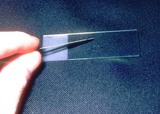 |
Scale and mineral oil are applied to a slide | The scale and mineral oil are applied to a slide. | Knowledge Weavers Dermatology | |
| 227 |
 |
Scalpel | This is a cross-sectional view demonstrating the blade angled away from the center of the ellipse. | Knowledge Weavers Dermatology | |
| 228 |
 |
Scalpel | This shows the scalpel, handle and blade. Note that the angle at the base of the blade, as well as the ankle at the attachment base of the scalpel handle should be the same. | Knowledge Weavers Dermatology | |
| 229 |
 |
Scalpel | A puncture should be made at both ends of the wound to ensure that the points of the ellipse are very sharp and pointed. The specimen can then be removed by cutting beneath the dermis with a scalpel as shown here. | Knowledge Weavers Dermatology | |
| 230 |
 |
Scalpel | The #15 blade and other small blades should be used by holding the scalpel handle as one holds a pencil. | Knowledge Weavers Dermatology | |
| 231 |
 |
Scalpel | This cross-section shows the angles that are left on the edges that will allow for excellent eversion or puckering of the wound when the wound is closed. | Knowledge Weavers Dermatology | |
| 232 |
 |
Scalpel | The blade should be slid on the handle until it locks into place. | Knowledge Weavers Dermatology | |
| 233 |
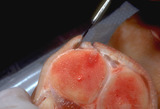 |
Scalpel | This shows the outward angle of the scalpel in a cross-sectional view. | Knowledge Weavers Dermatology | |
| 234 |
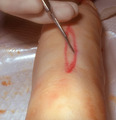 |
Scalpel | The other side of the ellipse is cut and the blade is angled outward. | Knowledge Weavers Dermatology | |
| 235 |
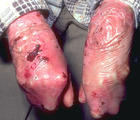 |
Scarring | Scarring occurs at sites where the epidermis tears off, and the digits normally scar together. | Knowledge Weavers Dermatology | |
| 236 |
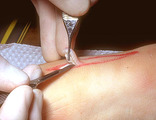 |
Scissors | The specimen can also be removed using scissors as one cuts beneath the dermis. | Knowledge Weavers Dermatology | |
| 237 |
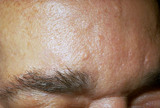 |
Sebaceous hyperplasia | Sebaceous hyperplasia. The lesions are flesh-colored or slightly white or yellow, are round, and often have a central indentation. They can be destroyed with electrocautery or laser. | Knowledge Weavers Dermatology | |
| 238 |
 |
Seborrheic dermatitis | Seborrheic dermatitis involving the beard. | Knowledge Weavers Dermatology | |
| 239 |
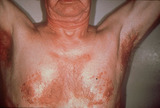 |
Seborrheic dermatitis | Seborrheic dermatitis involving the chest and armpits. | Knowledge Weavers Dermatology | |
| 240 |
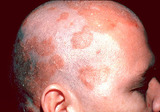 |
Seborrheic dermatitis | Seborrheic dermatitis involving the scalp; for whatever reason the patient shaved his scalp. | Knowledge Weavers Dermatology | |
| 241 |
 |
Seborrheic dermatitis | Seborrheic dermatitis involving the scalp. | Knowledge Weavers Dermatology | |
| 242 |
 |
Seborrheic keratoses | One month after freezing seborrheic keratoses showing slight residual inflammation and postinflammatory hyperpigmentation. This generally resolves within several months after the procedure. | Knowledge Weavers Dermatology | |
| 243 |
 |
Seborrheic keratoses | The appearance of seborrheic keratoses immediately following freezing. The lesions should be frozen (kept white, or have a thaw time of) 30 seconds. | Knowledge Weavers Dermatology | |
| 244 |
 |
Seborrheic keratoses | Seborrheic keratoses. They are a benign thickening and darkening of the epidermis with varying amounts of loose adherent scale. | Knowledge Weavers Dermatology | |
| 245 |
 |
Severe acne vulgaris | Severe acne vulgaris involving the back. | Knowledge Weavers Dermatology | |
| 246 |
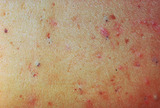 |
Severe acne vulgaris | Severe acne vulgaris involving the chest. | Knowledge Weavers Dermatology | |
| 247 |
 |
Severe acne vulgaris | Severe acne vulgaris involving the back, and associated keloidal scarring. | Knowledge Weavers Dermatology | |
| 248 |
 |
Severe nodulocystic acne | Severe nodulocystic acne virtually always requires Accutane to bring and keep it under control. Theoretically, the previously shown regimen of using an oral antibiotic, a topical antibacterial, and a comedolytic (Retin-A) should be used first, but rarely is this successful. I trained in the pre-Accu... | Accutane | Knowledge Weavers Dermatology |
| 249 |
 |
Severe nodulocystic acne | This is the back of the same patient shown in Slide 16, and the nodules, cysts, and scarring are evident. This is both painful and disfiguring, and can have a profound detrimental psychological effect on the person who suffers this. Thankfully, we do have effective therapy now for it. | Knowledge Weavers Dermatology | |
| 250 |
 |
Severe nodulocystic acne | This patient has severe nodulocystic acne. Not only does he have acne, but the inflammatory damage to the dermis has induced elevated scars called keloids. These are permanent. This type of acne rarely responds to creams and oral antibiotics, but does respond well to oral Accutane. | Accutane | Knowledge Weavers Dermatology |
